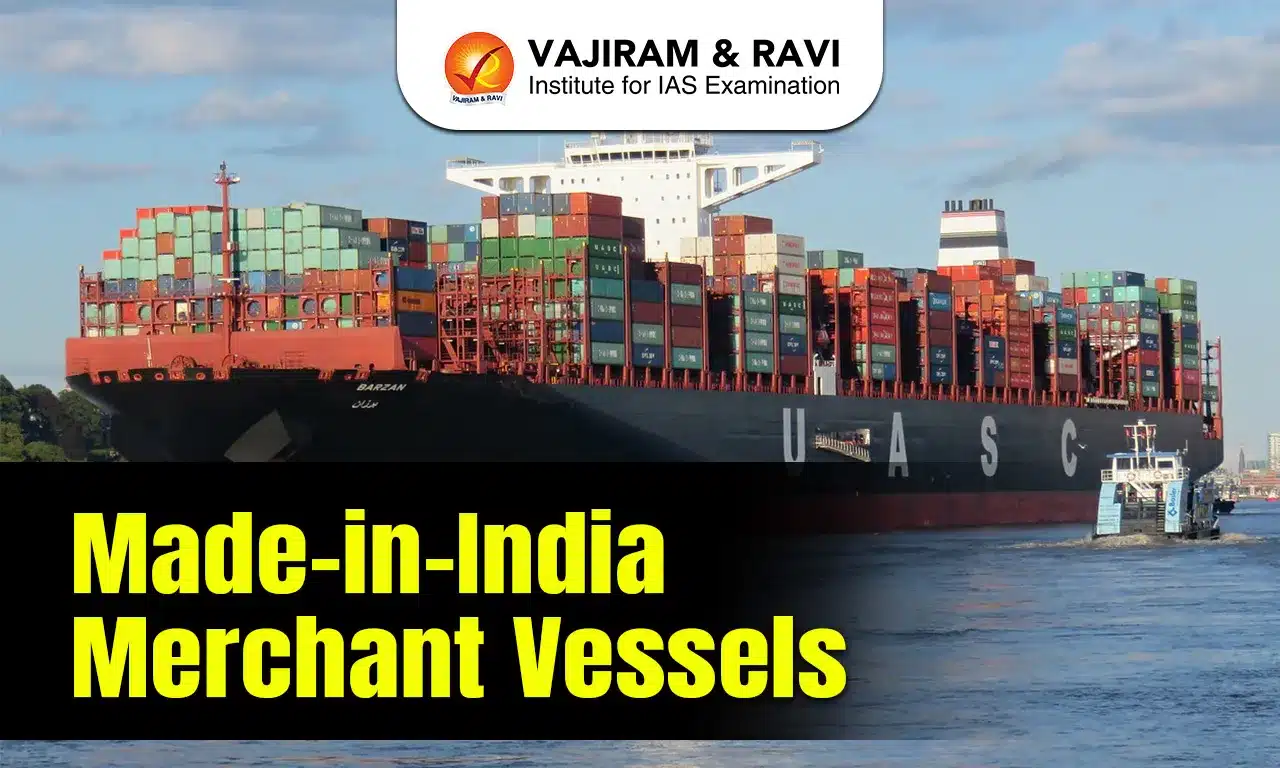Made-in-India Merchant Vessels Latest News
- The Centre has initiated efforts to expand India’s fleet of domestically built merchant ships, aiming to become a leading maritime nation within two decades.
- This step is driven by the need for self-reliance, as dependence on foreign ships poses risks during emergencies.
Challenges Faced by India’s Shipbuilding Sector
- India’s shipbuilding sector, which currently holds only 1.2% of global ship tonnage, is set for significant growth following policy reforms and financial support announced in Union Budget 2025-26.
Ongoing Challenges
- Small & Outdated Shipyards: Less automation, longer delivery timelines, and higher costs compared to China, Japan, and South Korea.
- Expensive Financing: Indian interest rates (9–10%) are nearly double those in global competitors.
- Import Dependency: Heavy reliance on imported marine-grade steel, navigation systems, and propulsion units.
- Weak Repair Ecosystem: India’s global share in ship repair is <1%; most Indian ships are serviced abroad due to cost and quality issues.
- Lack of Integrated Maritime Ecosystem: Bureaucratic delays and absence of dedicated maritime financing institutions continue to constrain growth.
India’s Push to Become a Global Maritime Power
- The Indian government has launched an ambitious initiative to significantly expand its fleet of large ‘Made in India’ merchant ships.
- The aim is to position India among the top maritime nations over the next two decades, with specific targets to be in the top 10 shipbuilding countries by 2030 and top 5 by 2047.
Need for Indigenous Fleet
- The move stems from strategic and security concerns.
- In times of emergency, such as conflicts or high-alert situations at ports, foreign ships may avoid Indian ports, disrupting trade.
- A self-reliant fleet would ensure continuity in trade and economic stability.
Role in National Development
- The initiative aligns with the government’s vision of making India a “developed nation” by 2047.
- Maritime power is seen as a critical pillar of that development journey.
Policy Measures and Financial Support
- Maritime Development Fund
- Rs 25,000 crore fund created (49% government-funded), to provide long-term, low-cost financing for shipbuilding, ship repair, and infrastructure.
- Expected to attract Rs 1.5 lakh crore investment by 2030.
- Shipbuilding Financial Assistance Policy (SBFAP) 2.0
- Outlay of Rs 18,090 crore to provide direct financial subsidies to Indian shipyards.
- Infrastructure Status
- Large ships now classified as infrastructure assets, enabling cheaper and longer-term financing.
- Shipbreaking Credit Note Scheme
- Offers 40% credit on the scrap value of old ships, usable for purchasing new ‘Made in India’ vessels.
- Customs Duty Exemptions
- Extended for 10 years on components used in shipbuilding and shipbreaking to reduce costs and boost domestic manufacturing.
- Maritime Triad Vision
- The long-term vision is to establish India as a dominant force in the full maritime value chain — shipbuilding, repairing, and recycling — reinforcing India’s position as a global maritime powerhouse.
Strategic Reforms in Shipping Laws
- Coastal Shipping Bill, 2024: Removes separation between coastal and riverine vessels, cutting transshipment costs.
- Merchant Shipping Bill, 2024: Expands ship ownership rights to NRIs, OCIs, and Indian-registered businesses, boosting investment.
- Bare Boat-cum-Demise Chartering: Allows staggered payments instead of upfront full vessel payment.
Strengthening India’s Maritime Finance and Shipbuilding Ecosystem
- Establishment of SCI Bharat IFSC Ltd
- A new shipping company, SCI Bharat IFSC Ltd, was incorporated in August 2024, at GIFT City, Gandhinagar.
- It is designed to operate under the ship leasing framework of the GIFT International Financial Services Centre (IFSC), focusing on vessel ownership, chartering, and other permitted shipping activities.
- Strategic Objective: 1,000 New Ships by 2034
- In collaboration with public sector oil, gas, and fertiliser companies, the government plans to expand the Indian merchant fleet by at least 1,000 ships in the next decade.
- This would reduce dependence on foreign ships and is expected to bring down freight costs by at least 33% by 2047.
- Current Status and Need for Growth
- India currently has about 1,500 merchant vessels, but only 50–60 are large ships.
- The policy push aims to trigger a substantial increase in large, domestically built ships to match global standards and secure India’s maritime trade interests.
- India’s Ship Recycling Strength
- India is already a global leader in ship recycling.
- In 2024, it ranked second globally in ship recycling by tonnage, with a 33% share in the global market.
- The Alang Ship Breaking Yard in Gujarat remains a vital hub, dismantling a significant portion of retired ships worldwide.
Made-in-India Merchant Vessels FAQs
Q1. Why is India expanding its merchant fleet?
Ans. To ensure trade security during crises and become a self-reliant maritime power under its Make in India vision.
Q2. What financial support has been announced?
Ans. ₹25,000 crore Maritime Development Fund and ₹18,090 crore subsidies under SBFAP 2.0 to boost domestic shipbuilding.
Q3. What are the major industry challenges?
Ans. High financing costs, outdated shipyards, import dependency, and a weak ship repair ecosystem hinder competitiveness.
Q4. What is SCI Bharat IFSC Ltd’s role?
Ans. A GIFT City-based company to lease and own vessels, helping expand India’s fleet by 1,000 ships by 2034.
Q5. How does India plan to lead globally?
Ans. By building strength across the maritime triad: shipbuilding, repairing, and recycling, targeting global leadership by 2047.
Last updated on June, 2025
→ UPSC Notification 2025 was released on 22nd January 2025.
→ UPSC Prelims Result 2025 is out now for the CSE held on 25 May 2025.
→ UPSC Prelims Question Paper 2025 and Unofficial Prelims Answer Key 2025 are available now.
→ UPSC Calendar 2026 is released on 15th May, 2025.
→ The UPSC Vacancy 2025 were released 1129, out of which 979 were for UPSC CSE and remaining 150 are for UPSC IFoS.
→ UPSC Mains 2025 will be conducted on 22nd August 2025.
→ UPSC Prelims 2026 will be conducted on 24th May, 2026 & UPSC Mains 2026 will be conducted on 21st August 2026.
→ The UPSC Selection Process is of 3 stages-Prelims, Mains and Interview.
→ UPSC Result 2024 is released with latest UPSC Marksheet 2024. Check Now!
→ UPSC Toppers List 2024 is released now. Shakti Dubey is UPSC AIR 1 2024 Topper.
→ Also check Best IAS Coaching in Delhi
Tags: made-in-india merchant vessels mains articles upsc current affairs upsc mains current affairs






















